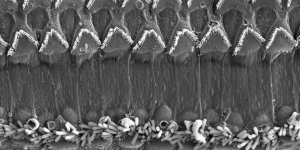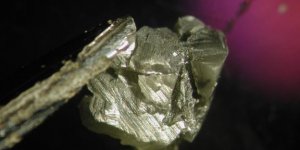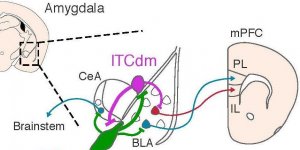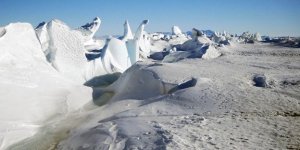Science News

Study shows link between mutations of GAS2 gene and ability to amplify incoming sound. »

Brigham Young University's holography research group has figured out how to create "lightsabers" -- green for Yoda and red for Darth Vader -- with actual luminous beams. »

Scientists find a new way to determine age of diamonds, and what made them. »

When Earth's temperatures spiked and oxygen levels in the ocean plummeted some 252 million years ago, (...) »

Scientists at Stony Brook University and (...) »

Findings on Neanderthal oral microbiomes offer new clues to evolution, health. »

Coral microbiomes recover from a laboratory-induced stressor. »

A team of volcanologists who observed the colossal 2018 eruption of Kīlauea, Hawai’i, have tracked how potentially toxic metals carried in its gas plumes were transported away from the volcano to be deposited on the landscape. »

Tsunami risk is higher for coastal cities adjacent to faults that traverse inland bays. »

Two clusters of brain cells compete to promote either the persistence or disappearance of traumatic memories, according to a new study conducted in mice. »

Sea ice cover in the Southern Hemisphere is extremely variable. »

A NASA team has found that organic, or carbon-containing, salts are likely present on Mars, with implications for the Red Planet's past habitability. »

A new study by a Belgian team using data from the European Southern Observatory’s (...) »

Discovery advances a range of robotic technologies. »

While scientists have amassed considerable knowledge of the rocky planets in our solar system, like Earth and Mars, much less is known about the icy water-rich planets, Neptune and Uranus. »

Researchers explain why people rarely remove something as a solution. »

Researchers are now able to wirelessly record the directly measured brain activity of patients living with (...) »

Shifts in plant microbiomes impact plant health. »

Bolts create reactive chemicals that affect greenhouse gases. »

Ankle exoskeleton system increased walking speed by about 40%. »

Study on Madagascar crocodile suggests that modern crocs likely originated in Africa. »

Melting glaciers redistributed enough water to cause the direction of polar wander to turn and accelerate eastward during the mid-1990s, according to a new study. »

Study shows decreased seedlings and saplings years after removal of the noise source. »

Deep-sea bacteria dissolve carbon-containing rocks, releasing excess carbon. »

Humans have a uniquely high density of sweat glands embedded in their skin -- 10 times the density of chimpanzees and macaques. »

Gemini North observations help identify rotational speed limit for brown dwarfs. »

Scientists have reconstructed ancient DNA from soil for the first time, in an advance that will significantly enhance the study of animal, plant and microorganism evolution. »

Study warns that cascading effects of salts require coordinated management. »

A new study of nearly 5 million live births recorded in California from 2001 to 2012 found that babies born (...) »

Expansion of artificial night light has important impacts on animal behavior and health. »

A unique residential study has concluded that, contrary to perceived wisdom, people with eating disorders do not lose self-control – leading to binge-eating – in response to stress. »

New cyan blue could be an alternative to synthetic blue food colorings. »

Study captures the structure of metallic glass. »

Changes in gene activity can link past experience with future behavior. »

New analysis of strontium isotopes reveals how the carbon cycle responds to changing climate. »

Using satellite data to ‘see in the dark’, researchers have shown for the first time that lakes on the Greenland Ice Sheet drain during (...) »

A large study of children has uncovered evidence that behavioral problems in children who snore (...) »

Certain brightly colored coral species dotting the seafloor may appear indistinguishable to divers and snorkelers, but Florida State University researchers have found that (...) »

Researchers confirmed the presence in the wild of Candida auris, a multidrug-resistant fungus commonly found infesting hospitals. »

The scientists say the seminal space rock that bathed Earth in Dino death is precisely what allowed our home planet to first host the lush, blooming rainforests we know today. »

Discovery may offer clues to carbon's role in planet and star formation. »

Astronomers have detected X-rays from Uranus for the first time, using NASA’s Chandra X-ray Observatory. This result may help scientists learn more about this enigmatic ice giant planet in our solar system. »

Congenital heart disease is the most common type of birth defect. »

Climate affects diet, evidenced by condition of Arctic foxes’ teeth. »

Researchers have uncovered evidence suggesting that volcanic carbon emissions were not a major driver in Earth’s most recent extinction event. »

New measurement technique unravels what gives hummingbird wings their characteristic sound. »

Pregnant women who consumed the caffeine equivalent of as little as half a cup of coffee a day on average had slightly smaller babies than pregnant (...) »

New research suggests that the ability of green algae to eat bacteria is more widespread than previously thought, a finding that could be important in environmental and climate science. »

Scientists at Clemson University have linked climate fluctuations over the past one and one-quarter centuries with flower color changes. »

Millions of tonnes of plastic and other debris released annually from coastal areas are transported by currents to mid-ocean garbage patches, especially in the North and South Pacific Ocean, and (...) »